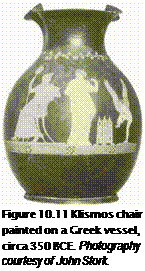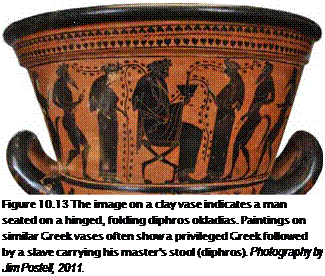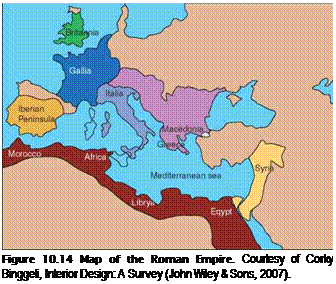From 600-404 BCE, the city-states of ancient Greece fostered an overall spirit of inquiry and sought scientific and philosophical solutions to problems of daily life. Much of our understanding of ancient Greek furniture is based on the few surviving pieces on display in museums, as well as the representation of furniture on painted vases and incorporated in sculptural relief. These artifacts provide knowledge regarding the fabrication and use of six types of Greek furniture:
■ Chests
■ Diphros (footstool)
■ Kline (reclining couch)
■ Klismos chair
■ Trapezai (tables)
■ Thronelike chair
|

 Greek furniture was used in a combination of practical and ceremonial functions tied to its developing democratic society, indicative of an egalitarian civilization. Most pieces were used for sitting, lounging, and eating (Figure 10.10).
Greek furniture was used in a combination of practical and ceremonial functions tied to its developing democratic society, indicative of an egalitarian civilization. Most pieces were used for sitting, lounging, and eating (Figure 10.10).
Greece had an abundant supply of timber. Wood species such as beech, citrus, maple, oak, olive, walnut, and willow made it unnecessary to use veneers. Marble and bronze were used in conjunction with or as a replacement for wood in special furniture pieces, which denoted their importance for special functions. Wood joints were held together with tenons, hide glue, and nails. Carved, worked, and inlaid ivory, ebony, precious stones, and silver were common ornamentation for couches, chairs, and chests. In addition to the range of existing Egyptian tools, the Greeks improved upon the Egyptian hand plane. The introduction of the lathe around 700 BCE enabled furniture legs to be turned.
The Greek kline was a couch with a headboard and footboard. It was usually made of wood (maple or olive) and sometimes made of metal (iron or bronze). It was used occasionally for eating with another person or reclining alone. Klinai were typically located in a room used for dining that later evolved into the Roman triclinium. For dining, a low table was used to hold food at the level of the recliner and could slide under the kline when not in use. The kline serves as a typological model for the contemporary recliner, as is evident in the origin of the word recline. It also is similar to the modern chaise longue, used for sleeping, eating, lounging, or conversing.
The thronos was a chair of honor for the most important person present. It was used in both domestic environments and ceremonial environments. Lekthoi (loosely covered couches) were common but are not technically considered upholstery, which developed several hundred years later. The klismos (Figures 10.11 and 10.12) was a wooden armless chair with outwardly curved legs. Over the course of several hundred years, the klismos side chair became remarkably well proportioned and was associated with domestic Greek life between 700 and 400 BCE, as is evident in surviving Greek art and pottery decoration (see Chapter 4).
The diphros was a stool without arms or back (Figure 10.13). It was made of wood. There were two types: one with fixed legs, the other with folding legs. Those with fixed legs had cylindrical legs turned on a lathe rigidly fixed at the four corners of the stool. Those that were folding had two pairs of legs crossed in an X shape and hinged together in the middle. The legs were often shown in the profile of deer feet. Diphrai were used indoors and outdoors.
Etruria was a prosperous settled society of linked city-states in northern Italy between 600 and 300 BCE. The Etruscans had established trade with Greece. Etruscan ideas about furniture design were adopted from Magna Grecia. The remains of magnificent murals from Etruscan tomb paintings, such as those from the towns of Cerveteri and Tarquinii, provide considerable insight into the comforts of the Etruscan way of life. The furnishings found in the carved and painted tombs reveal the importance placed upon the afterlife, though early tombs contained urns for ashes, not coffins for bodies.
 A recurring theme in Etruscan tomb murals is the banquet—part of the religious ceremony at funerals. After the formal funeral ceremonies were complete, the relatives of the deceased would have been treated to a banquet, which the spirit of the departed was believed to attend. In Etruscan life, the banquet was a status event, indicating that the hosts had "arrived" in the estimation of the social elite. Lavish receptions were provided, at which the guests reclined on couches, were waited on, and were entertained by musicians and dancers. Tables were covered with embroidered tablecloths on which dinner courses were served. The importance of the meal gave consequence to the furnishings used for dining.
A recurring theme in Etruscan tomb murals is the banquet—part of the religious ceremony at funerals. After the formal funeral ceremonies were complete, the relatives of the deceased would have been treated to a banquet, which the spirit of the departed was believed to attend. In Etruscan life, the banquet was a status event, indicating that the hosts had "arrived" in the estimation of the social elite. Lavish receptions were provided, at which the guests reclined on couches, were waited on, and were entertained by musicians and dancers. Tables were covered with embroidered tablecloths on which dinner courses were served. The importance of the meal gave consequence to the furnishings used for dining.
Evidence of craftsmen working in wood, stone, bronze, textiles, and painting abounds. With the availability of bronze, a number of bronze chests, hardware, weapons, and domestic accessories, such as candlesticks, were fabricated as early as 700 BCE. The workmanship and design of small bronze tables were remarkable in their circular form, supported by pawshaped feet and engraved with figures.
 The Etruscans were active in the trading network surrounding the Mediterranean Sea. Their bronze artifacts have been identified as far west as Madeira, Spain, and as far north as Hassle, Sweden. This is an important point, demonstrating that furniture and furnishings have cultural and societal value as well as economic value. Through the exchange and trade of furniture, civilizations and societies adapted each other’s cultural values.
The Etruscans were active in the trading network surrounding the Mediterranean Sea. Their bronze artifacts have been identified as far west as Madeira, Spain, and as far north as Hassle, Sweden. This is an important point, demonstrating that furniture and furnishings have cultural and societal value as well as economic value. Through the exchange and trade of furniture, civilizations and societies adapted each other’s cultural values.

